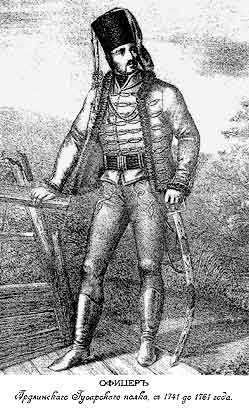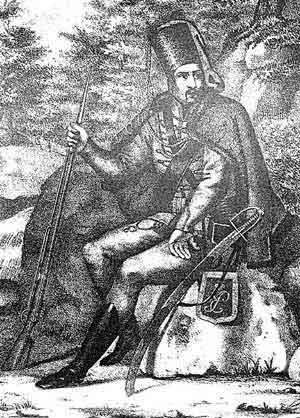|

Russian Hussars and
Pandurs

Russian regular army
in the SYW was mono-national, with the only exception for
light cavalry, consisted of regiments of Pandur Hussars.
They were raised from Serbs, Hungarians, Georgians,
Wallachians & Moldavians. To explain their origins I
have to make a brief excursion to the 1730-ths.
During the War 1736-39
with Turkey, many volunteers from Orthodox countries
(Serbia, Moldavia, Wallachia & Georgia) entered Russian
service & raised numerous volunteer troops of light
cavalry, commonly named Hussars. When the War ended, most of
them wished to stay in Russia, because they were from
countries stayed under Turkey rule & couldn't return
home. They were allowed to stay in Russia & were
suggested either to enlist Russian regular army or to settle
in the Southern regions of Ukraine. This predetermined the
following development of Pandur troops in Russia: some of
them became a part of the regular army, other formed settled
military like Austrian Grenz military.
Regular Hussar regiments
Origin
On October 14, 1741 Princess Anna
Leopoldovna of Braunschweig-Lunenburg, who ruled Russia from
November 11, 1740 to November 25, 1741, authorized the
raising of 4 Hussar regiments from natives who had remained
in Russia:
Serbskiy
(Serbian)
Moldavskiy
(Moldavian)
Vengerskiy
(Hungarian)
Gruzinskiy
(Georgian)
They were raised from above-mentioned
various Hussar companies, converted to regular service after
the War 1736-39. This regiments were enlisted, not
conscripted as the rest of Russian army, & were on a
level between regular and irregular cavalry. Hussars were
recruited only from the title nation, i.e. this regiments
were national units on Russian service: all troops (incl.
officers) were national and commands were given in the
national languages. Each regiment was supposed to have a
fixed organization of 10 companies, each of about 100 men,
but these regiments were recruited from different sources,
so they were less then authorized strength.
Later in 1759-60 3 more Hussar regiments
were raised:
Zeltiy
(Yellow)
Makedonskiy
(Macedonian)
Bolgarskiy
(Bulgarian)
but completed was only Yellow Hussars,
& they took part in the final actions of the
SYW.
Pandur Hussars took active part in the
SYW, for details see Regimental histories.

Hungarian, Yellow, Georgian, Moldavian
and Serbian Hussars
Uniform
& equipment
I have not found the exact date when the
Hussars received their first uniform regulation. I believe
it was about 1741-42 and dated from first years of the reign
of Empress Elizabeth. Nevertheless, Viskovatov in
"Historical description..." (Vol. 3, p. 56) gives a detailed
description of their uniform and equipment. Russian Hussars
received uniform like Austrian one.

Georgian Hussar-Officer from
Viskovatov
Uniform. Pelisse: short cloth jacket without collar,
decorated with cords and buttons. Pelisse was trimmed with
black fur & was usually worn over the left shoulder. It
was worn as a jacket only in inclement weather. Dolman:
cloth jacket with small stand-up collar, decorated with
cords and buttons. The Dolman was bordered with lace of the
same colour with cords. Usually it was belted with Kushak, a
wide barrel sash. It had two parts: the base barrel sash
& some vertical barrels. They were of different colors.
As a rule, vertical parts were the same color with cords
& lace. Chashkirry: tight, cloth breeches decorated with
cords. Epancha: a kind of cloak used in Russian army. It
reached mid-calf. The Epancha was worn in cold and inclement
weather. Black cloth cravat. Tsipely: short leather boots,
as a rule black. All buttons on the dress were copper.
Shako: a fur head-dress decorated with cords, with the top
of the regimental color.
Equipment. Broadsword or sabre: worn in leather
sheath with metal fittingd. The sheath was carried on a
special belt, called a Pasak. It was hidden under Kushak.
Sabretache: leather with a cloth cover. It was suspended
from 3 straps on the left side, and dangled about knee. It
was decorated with monogram and bordered with lace of the
same color as the monogram. A short Fusil or Carbine with
bayonet. Baldric was worn over the left shoulder and
Cartridge-box over right shoulder. All cross belts were made
of black leather. Mounted Hussars also had a pair of pistols
carried in the saddle holsters.
Rank distinctions. Non-commissioned officers
(corporals, quartermasters, vakhmeisters) had the same
uniform and armament as the other ranks but wool lace
changed to gold. All non-commission officers had one braid
on the border of the collar. Quartermasters also had one
braid on sleeves & vakhmeister (senior corporal in
Pandur units) - two. Corporals did not have any special
distinctions, except the braid on the collar. Hussars
non-commission officers were armed with a sabre & a pare
of pistols. Their equipment consisted of a sabretache &
pistol cartouche.

Georgian Hussar-Private from
Viskovatov
Hussar officer wore the same uniform like
other ranks but better decorated. All cords & lace were
gold in spite of the regimental color. Tsipely were yellow.
They were armed with sabre & a pare of
pistols.
Hussars did not powder and plait their
hair. Usually they grew it in long curls and wore long
hanging moustaches.
Musicians. Each regiment had 1 kettle-drummer &
10 trumpeters, one for each company. They changed from other
Hussars by small wings on shoulders & galloon of
different colors. Unfortunately, this decorations were not
regulated punctually & images of Hussars musicians
didn't saved. All musical instruments were made from copper
in regular cavalry pattern and decorated with lace &
cords of the regimental color.
Vlad
Gromoboy

|
